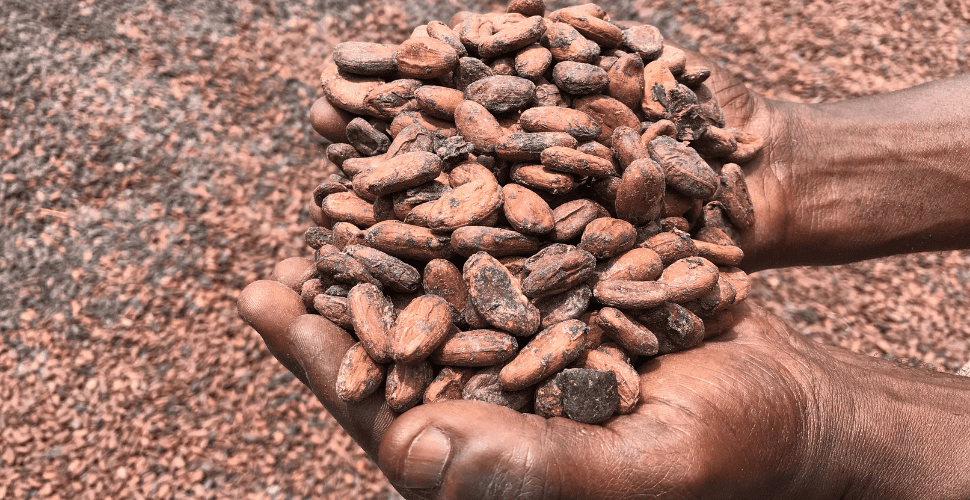Whether we’re celebrating or commiserating, chocolate is a sweet and familiar companion for many of us. But when we take the time to learn about cocoa’s global value chain, the social and environmental costs it currently entails leave a bitter taste in our mouths.
The reality is that the chocolate industry’s current business model leaves cocoa farmers living below the poverty line. To meet production demands and lift themselves out of poverty, farmers often turn to using children as a cheap labor source.
Many children working in cocoa carry out hazardous tasks, such as clearing forests with sharp machetes, carrying heavy sacks of cocoa and handling dangerous pesticides. There have also been some incidences of children being trafficked from neighboring countries and forced to work in cocoa farms against their will.
The low price of cocoa also drives many farmers to employ unsustainable techniques, such as the clearing of old growth forests and the use of harmful pesticides. These practices take a toll on the health and wellbeing of farmers and their communities.
So, what can we do about it?
As consumers, we know we have the power to drive sweeping industry change by holding major chocolate brands accountable for their impact on people and the planet.
We’re building a movement of informed chocolate consumers demanding change. Join us by learning which brands are improving their policies and which brands are falling short. The 2022 Chocolate Scorecard helps you make better decisions about which brands you support and which brands you call for change from.
For industry-wide change, we need a movement of millions. Be part of the solution by making a ripple in your own social circles. Follow our tips for sharing the scorecard and let’s build a network of informed consumers that brands cannot ignore.
Step 1: Getting informed
As consumers, it can be hard to cut through the marketing speak of major brands and understand their true impact on the communities involved in their supply chains.
That’s where the Chocolate Scorecard comes in. The Scorecard provides the most up-to-date and comprehensive overview of which brands are rising to the challenge of creating a chocolate industry that is good for people and the planet. It also calls out the “rotten eggs” for ignoring your demands for greater transparency and more ethical policies for slavery-free chocolate.
READ THE 2022 CHOCOLATE SCORECARD
Leading researchers and subject matter experts have come together to survey and grade 38 major chocolate brands on their policies related to child labor, living income, traceability & transparency, deforestation & climate, agroforestry, and agrichemical management.
Get informed about how different brands are performing on these issues by reading the scorecard. The ratings will help you choose which chocolate brands to support and which ones you might want to steer clear of until they show proof of improved policies.
Step 2: Spread the word
Almost 180,000 of you have been calling for change from major chocolate companies, along with numerous civil society groups and associations. And we’re making a difference!
But to truly transform a multi-billion-dollar industry, we’ll have to build an even louder and even larger movement of informed consumers demanding change. If 180,000 of us were to share the scorecard with 50 people each, there would be 9 million people making better choices about their chocolate consumption.
Does 50 people sound like a lot? Here are some ideas of how and where you can share the scorecard!
Share it with your online audience
- Tweet this post
- Share a screenshot on Instagram
- Tell your Facebook friends about it
- Write about it on LinkedIn
- Email it
- Send it to any online notice board groups you think would be interested
Share it with your phone contacts
- Link it to your WhatsApp groups
- Copy this link into an SMS or any other mobile messaging app
Done with digital? Share it in real life
- Leave the scorecard in waiting rooms or on notice boards
- Send it to school for show and tell
- Involved in a club, association or group? Tell them about it IRL!
Get the media onboard
- Send it to your local media outlets and tell them you want to see it covered
Inform vendors
- Who is selling and using chocolate in your area? Shops, cafés, restaurants, canteens… Inform them!
Have more ideas? Share them in the comments so that others can learn from them!
Step 3: Tell us about your campaigning!
There’s no movement without community. You can inspire others to take action by telling like-minded individuals about how you’re spreading the word and pushing the movement forward.
Use the action recorder below to register your efforts and tell us in the comments below what you’ve been doing to drive industry change.
You can also share your pictures and videos of you sharing the scorecard by email or by tagging us on social media! We’d love to see you in action and share your hard work with the rest of the community.
By buying ethically sourced chocolate and working with chocolate companies to improve standards, we can—and do!—make a difference.







Hello, Lamees. Thanks for your question! Mondelez was given the yellow egg for child labor which means they are “starting to implement good policies.” It’s important to bear in mind that this scorecard ranks these companies relative to each other. So a good rating means a company is performing well compared to other companies in the industry, not that their practices and policies are perfect. We were obviously saddened to see the cases of exploitation featured in the Dispatches episode, but we weren’t surprised. With 1.53 million children purported to be exposed to child labor and 1.48 million children exposed… Read more »
I asked all my colleagues at work what is their favourite brand of chocolate. They got excited and probably thought that I am going to get them some 🙂 Then I printed the information regarding their favourites and explained what they were looking at. They were really intrigued, so I sent the link with a full scorecard around.
Thank you very much for your answer! That explains a lot, it’s sad, but I understand now this is in relation to something even bigger, less-regulated and more well-hidden… thank you very much.
Hello, Jacqueline. Thanks for your feedback! Taken together, these 38 companies make up 80-90% of the world’s cocoa. But the scorecard grows each year, and we hope to see more and more companies join in future, hopefully including your favorite brand! In solidarity, Monica.
Hello, Marjorie. Thanks for your feedback! Taken together, these 38 companies make up 80-90% of the world’s cocoa. But the scorecard grows each year, and we hope to see more and more companies join in future. There are a few other Fairtrade brands in there if you’re looking to see how they perform specifically. In solidarity, Monica.